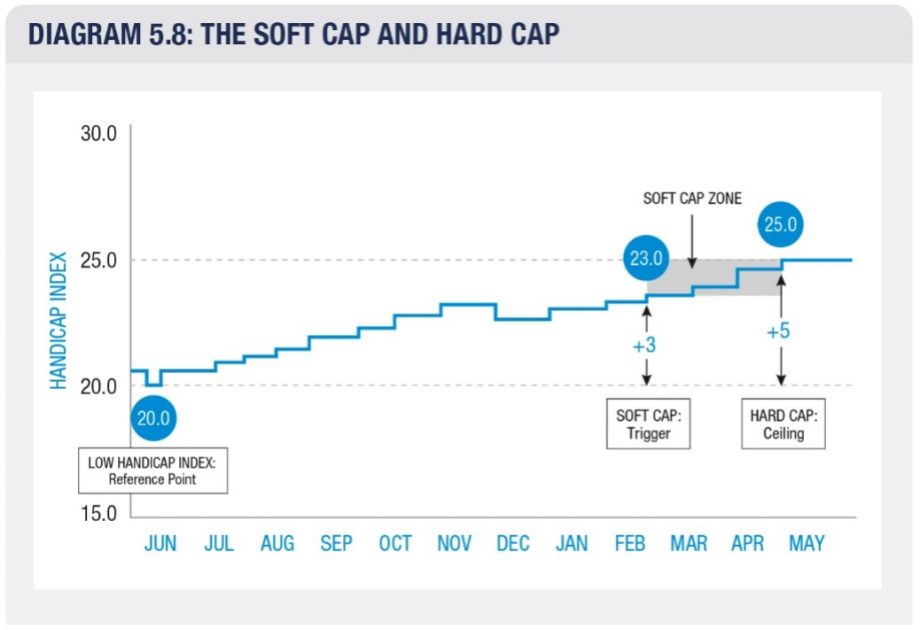Category: Knowledge Center
Do you want to know how your golf handicap is calculated? In this article, we will walk you through the step-by-step process of how we calculate your handicap. We will explain everything you need to know, including what your teeing handicap means. Let's get started!
To get a handicap you first need to enter a minimum of 5 gross scores into the Birdie system. Let's assume you entered these scores and you are male:
93 gross at Green Valley Rayong on 10/4/2022 from the White tees
89 gross at Royal Lakeside on 11/4/2022 from the White tees
98 gross at Siam Country Club on 12/4/2022 from the Black tees
84 gross at Laem Chabang AB on 13/4/2022 from the White tees
88 gross at Chee Chan on 14/4/2022 from the Blue tees
Notes:
After entering the scores, the system calculates what are known as differentials. For the scores above the following is calcualted:
(Gross Score - Course Rating) x 113/Slope Rating = Differential
(93 - 70.1) x 113/125 = 20.60
(89 - 70.2) x 113/129 = 16.35
(98 - 74.5) x 113/133 = 19.74
(84 - 68.6) x 113/122 = 14.16
(88 - 73) x 113/133 = 12.60
Notes:
| Number of Score Differentials in scoring record | Score Differentials to be used |
| 5 | Lowest 1 |
| 6 | Average of lowest 2 |
| 7 or 8 | Average of lowest 2 |
| 9 to 11 | Average of lowest 3 |
| 12 to 14 | Average of lowest 4 |
| 15 or 16 | Average of lowest 5 |
| 17 or 18 | Average of lowest 6 |
| 19 | Average of lowest 7 |
| 20 | Average of lowest 8 |
From here the average of the differentials is given a bonus for excellence and that figure is multiplied by 0.96. We only go to 1 decimal place.
You now have a starting handicap! and we move on to maintaining that starting handicap
After you have established a handicap there is an important step that you now have to take, which is the AGS (Adjusted Gross Score). This means you can no longer just enter your gross score, you have have to adjust every hole score to no more than a NET DOUBLE BOGEY.
For example: You have entered your first 5 scores and Birdie has given you a handicap of 18. You play at a local course and Birdie gives you a teeing handicap of 20. (Teeing handicap explained below)
This teeing handicap means you get 1 extra shot over par on 16 holes and 2 extra shots over par on the 2 hardest holes. If you score more than a NET DOUBLE BOGEY on these holes you should adjust the score down to a NET DOUBLE BOGEY for handicap purposes.
Once you understand this you can enter your next score where the following calculations take place:
Your handicap can be described as a moving average. As you enter scores the previous scores become obsolete. A score continues to be part of the handicap calculation if it remains with the player’s most recent 20 scores, regardless of the age of the score. A score could be from 5 years ago but it still counts towards your handicap if it is within the last 20 scores
The low handicap is a player's lowest handicap going back 365 days from your last score entered into the system.
Once a player has a low handicap within 365 days, that low handicap is reevaluated every time a new score is entered as going back 365 days is constantly moving.
A soft cap is part of the handicap calculation to limit the upward movement of the handicap is associated with the lowest handicap over the last 365 days.
The soft cap is triggered when the difference between a player's handicap and their lowest handicap over the last 365 days is greater than 3. That doesn't mean you can not increase your handicap by more than 3 shots in the space of 365 days, it just means the upward movement is suppressed to make it take longer.
A hard cap is another limit on the upward movement of the handicap over 365 day period. If a player continues to card scores that increase his/her handicap, the soft cap kicks in first, and if the scores continue to get worse the hard cap kicks in.
A hard cap kicks in if the difference between the calculated handicap is greater than 5 shots over the lowest handicap in 365 days.

An exceptional score is anything better than 7 shots below the player's current handicap. If an exceptional score is carded the following takes place:
|
Number of strokes the Score Differential is lower than a player’s Handicap Index in effect when the round was played |
Exceptional Score reduction |
| 7.0 - 9.9 | minus 1 shot |
| 10.0 or more | minus 2 shots |
This is a statistical calculation that determines if conditions on a day of play differed from normal playing conditions to the extent that they significantly impacted a player’s performance. We decided to omit this calculation which is used in some countries because the weather in Thailand is fairly stable all year round. When there is a storm players rarely play through it, it would be common practice to stop at the drinks stop and wait it out.
A Teeing handicap is the handicap that a player receives from the set of tees that they plan on playing. The teeing handicap is different for each set of tees because a course will play different from each set of tees. i.e How can your handicap be the same playing 7400 yards from the back tees and then the next day playing 6200 yards from the forward tees?
The teeing handicap takes these factors and others into account to give you a fair handicap for the set of tees you are playing.
Golf handicaps and how they are calculated are a complicated subject made even more difficult by the recent inclusions from the World Handicapping System but fear not, you don't have to do anything other than adjust your gross score before entering a score. Birdie Thailand takes care of all the heavy lifting so you can concentrate on your game
Happy Golfing!
IF YOU STILL QUESTIONS, PLEASE LET ME KNOW IN THE COMMENTS BELOW AND I WILL DO MY BEST TO ANSWER THEM

 Birdie
BirdieBirdie is designed for Golfers in Thailand to manage their scores and handicap, analyse their game, find courses, and to interact with other golfers.
By partnering with Birdie you can publish green fee deals, event promotions, and updates about your golf course.
Email us for more information: shane@birdie.in.th
Making golfing in Thailand better.
![]() © 2017 Birdie.in.th
© 2017 Birdie.in.th
เปลี่ยนเป็นภาษาไทย
Privacy Policy
Terms and Conditions
![]() © 2017 Birdie.in.th
© 2017 Birdie.in.th
Privacy Policy
Terms and Conditions
Gavin Steacy
24 Mar, 2024 12:37
So just to be clear, let's say my first 5 gross score rounds were to give me a handicap of 18 and therefore an extra stroke per hole
In my 6th round, if on the first hole, say a par 4, I scored an 8 therefore I would enter a 7 for handicapp purposes, as that is a net double bogey above my allowed shots. Is that correct?